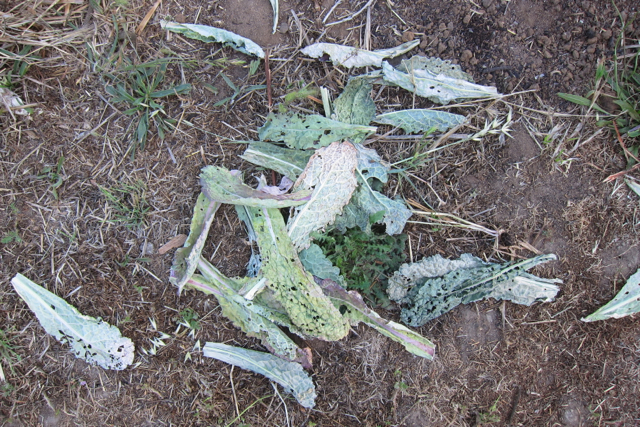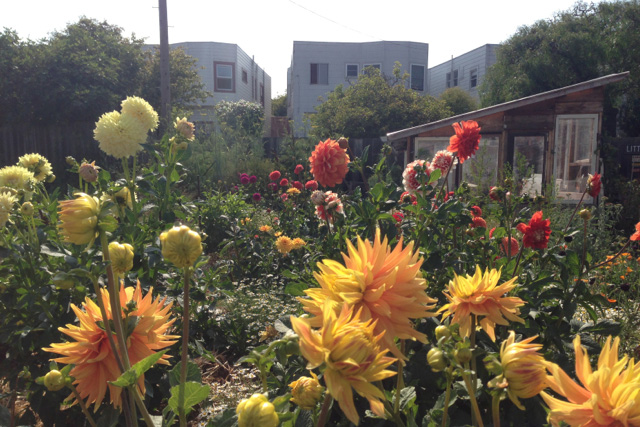troubleshooting
July 11th, 2013 by caitlynSometimes I feel like a bad farmer. The beets are weedy and stunted, a third of the kale crop is becoming overrun with aphids, crop record keeping has fallen by the wayside the past few months, and the germinating buckwheat cover crop is mysteriously yellowing before it even sprouts true leaves. When I fix one irrigation leak here, I notice another three over there, and the weeds outside the front fence are so big that they’re leaning over onto the sidewalk. The neighbors must hate me!
And then other times, I cut myself some slack. The rainbow chard is continuously lush and abundant, showing deep healthy colors. I’ve been staying on top of the books a little better this year, we finally have an established bronze fennel crop, and watching our declining, troubled collards bounce back after some thorough irrigation repair and appropriate fertlizing actually made me feel like a real farm hero for a minute. Plus, I think the neighbors really do like me.
I feel like a broken record sometimes, but I have to remind myself month after month, year after year, that farming is composed of constant ups and downs. I would bet that even for the most experienced and organized, farming is still always a complicated orchestration of surprises. There are so many seedlings to pay attention to, availability lists to update, insects to identify and emails to respond to! For the past three years, I’ve been perpetually swirling, never feeling quite on top of every last detail.
Thank goodness for the dahlias. They are my cheerleaders!
Despite the occasional frustrations, we are in the middle of a productive season and overall the farm is doing well. I am so grateful for all the steady volunteers and interns at the farm (introductions coming soon) which is helping to smooth out this transition period after Brooke’s departure. A lot of food is coming out of the half of the farm that we currently cultivate — somewhere close to 200 lbs per week of greens, herbs, onions, fennel, artichokes, root crops, summer squash, and more — and we are keeping up with consistent weekly restaurant sales. Salad mix production is paused for the time being (it’s far too labor intensive for this scaled back year), but we’ve expanded our cut flower production quite a bit and plan to sell bouquets this summer in order to supplement produce sales. We’re almost done building a small shade structure to store produce bins on harvest days — something we’ve needed for years — and we’ve more than doubled the size of our culinary herb patch.
The farm is still a scaled back version of previous years (intentionally), and this still feels appropriate and necessary. I think it was a good decision. In addition to being able to relieve some financial pressure by increasing my off-farm work, I’ve also had the time to pay closer attention to what’s happening at the farm, and because of that I’m coming to the conclusion that most of the problems that have arisen in the past year boil down to soil issues that need to be seriously addressed. While farmers operating on a larger scale have room to rotate crops around a bit more, or even let entire fields fallow between seasons, our rotations have always been much tighter in order to maximize space/time and grow as much food as possible. Even after nurturing this soil to the best of our abilities, it’s apparent in each discolored leaf that our soil care regimen needs evolving. Compost forked into every turned bed, with an occasional fava/pea cover crop rotated in just isn’t cutting it. We need to find a way to diversify our tactics, as something is becoming noticeably out of balance. And of course we all know that it’s soil that successful farmers grow, not vegetables.
I’ll start with another soil test (long overdue), and I’ll consult with fellow farmers. I’ll do my own research and I’ll report back here with findings as I go. I may have to change production plans for the fall in order to focus on soil building, but I suppose that seems fitting with this year’s theme of transition and refocus. Sometimes you have to zoom out a bit and review the big picture in order to be sure you’re still moving forward. It feels appropriate and exciting to invest some time toward the building of fertility for future farmers on this small piece of land that has incredible potential.



i love the dahlias! your writing is excellent and filled with honest tenderness.
All is so right with the world when the farmer actually sees the condition of the crop; walks the fields daily, stoops down to inspect the leaf, limits spraying in exchange for the farmers’s shadow. You are doing a great job!
You are doing a great job, just by putting seeds in the ground! You go!
As for the kale, we have had some problems with our kale this season, with flea beetles… and a farmer friend of mine suggested to remove any large outer leaves and leave only a tiny bud in the center. This removes a large portion of the food supply for the little buggies and their population can’t be supported and dies off. Kale is so resilient and grows back in a couple of weeks! By the time it grows back the bugs are long gone and you hopefully have beautiful kale again. This has worked well for us!
Hope this helps and happy growing!
From Big Muddy Urban Farm in Omaha,
Ali
I’m probably late to the game but I grow buckwheat as a cover crop and as forage for my bees in Daly City. Yellowing and stunting seem to suggest they don’t have enough nitrogen. Clover might do better or you could add fish meal.
Thank you everyone for the tips and encouragement!
hey there fellow farmer, it’s good to be reminded that all farmers have their constant ups and downs. i feel that every season, never quite on top of it all. i’d love to come for a visit soon, we’ve fallen out of touch but i think of you often! xo